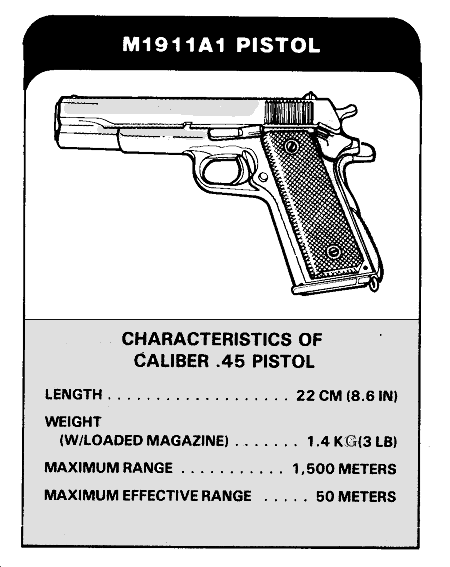You must know how to fire your weapon and how to control your fire. This
appendix covers the characteristics of the weapons you will be using and
discusses characteristics of fire and methods of fire control.
This pistol fires caliber .45 rounds. It is a semiautomatic, recoil-operated
magazine-fed handgun. It fires one round each time the trigger is pulled. Its
magazine holds seven rounds. The top round is stripped from the magazine and
chambered by the forward movement of the slide. When the last round in the
magazine has been fired, the slide stays to the rear.
This rifle fires 5.56-mm rounds. It is magazine-fed and gas-operated. It can
shoot either semiautomatic or automatic fire through the use of a selector
lever. The most stable firing positions (those which allow the most accurate
fire) are the prone supported or standing supported for semiautomatic fire and
the prone bipod supported for automatic fire.
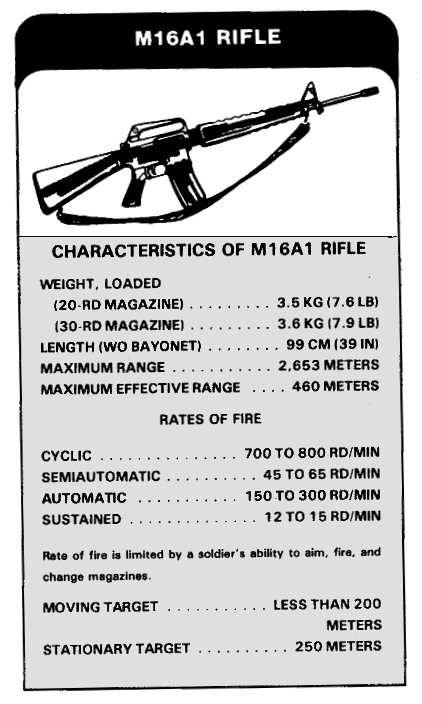
M60 MACHINE GUN
This gun fires 7.62-mm rounds. It is belt-fed, gas-operated, and automatic.
It has an attached bipod and a separate tripod mount. The prone position, using
the M122 tripod and the traversing and elevating mechanism, allows the most
accurate fire. Some vehicular mounts, such as the pedestal mount on the M151
1/4-ton vehicle, are available for this gun. When the gunner is standing, the
gun may be fired from the hip, underarm, or shoulder firing position.
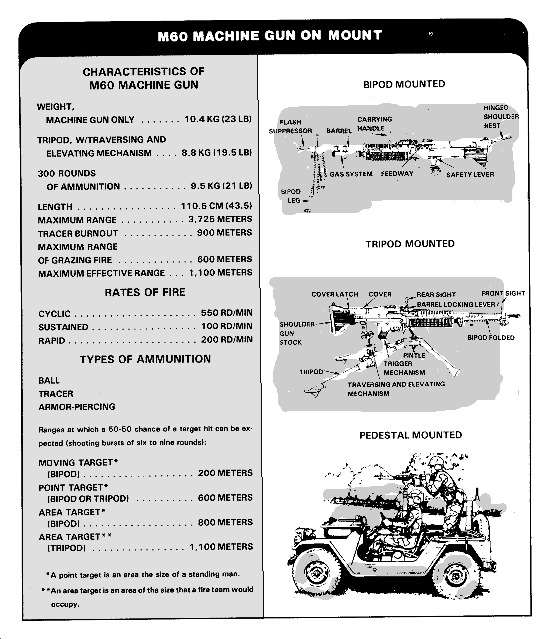
40-MM GRENADE LAUNCHER, M203
This grenade launcher (GL) is attached to an M16A1 rifle. The rifle has
already been discussed. The GL is a single-shot, breech-loaded, pump-action
weapon. It fires a variety of rounds. It can be used to suppress targets in
defilade. The GL can be used to suppress or disable armored vehicles, except
tanks. Its HEDP round can penetrate concrete, timber, sandbagged weapon
positions, and some buildings. Other rounds can be used to illuminate and
signal. The most stable firing positions are the standing supported and the
prone supported.
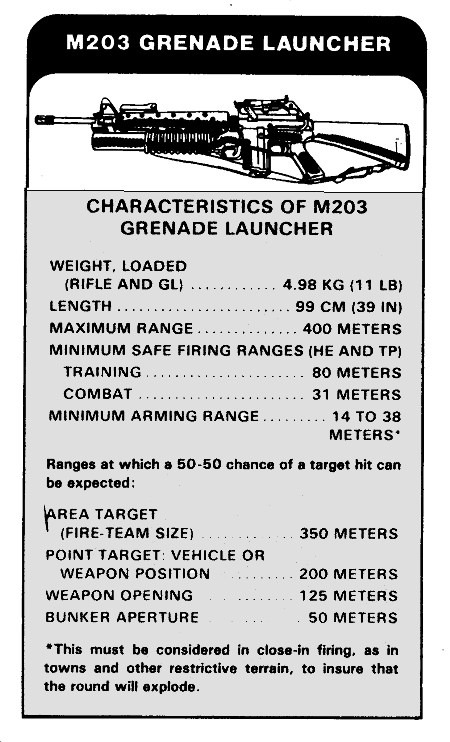
M433 High-Explosive Dual Purpose (HEDP) Round. This round can
penetrate 5 cm (2 in) of armorplate, 30 cm (12 in) of pine logs, 40 cm (16 in)
of concrete blocks, or 50 cm (20 in) of sandbags at ranges up to 400 meters. It
has a 5-meter casualty radius against exposed troops.

M651 CS Round. This chemical round is used to drive the enemy from
bunkers or enclosed positions in built-up areas.
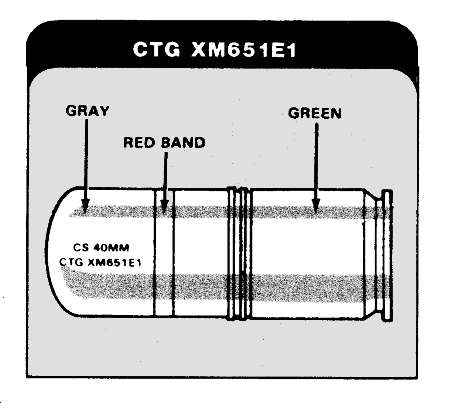
M583 White Star Parachute/M661 Green Star Parachute/M662 Red Star Parachute
Rounds. These are used to signal and illuminate. One can be placed 300
meters forward of a squad to illuminate an area 200 meters in diameter for 40
seconds.
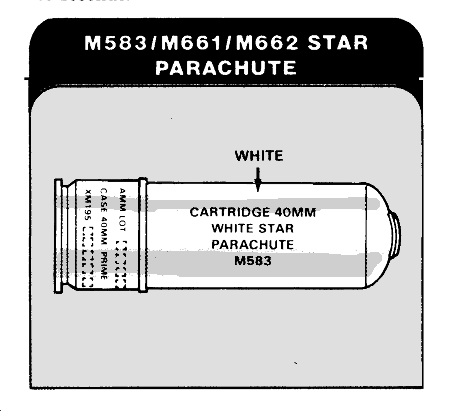
M585 White Star Cluster/M663 Green Star Cluster/M664 Red Star Cluster
Rounds. They are used to signal.
|
NOTE:
THE GREEN STAR CLUSTER MAY APPEAR WHITE IN BRIGHT
SUNLIGHT. |
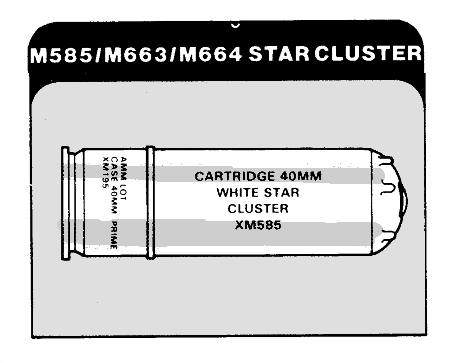
M713 Red Ground Smoke/M715 Green Smoke/M716 Yellow Smoke Rounds.
These are used to mark locations, not for screening.

LIGHT ANTITANK WEAPON (LAW)
This is a shoulder-fired, short-range antitank weapon. The most stable firing
positions for firing LAWs are the standing supported, prone, and prone
supported.
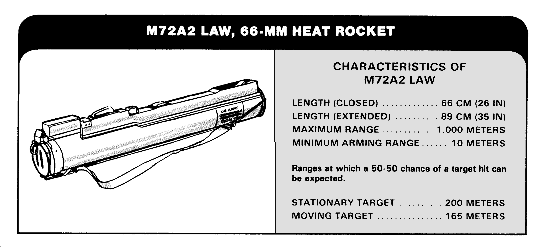
The M72A2 LAW consists of a 66-mm HEAT (high explosive antitank) rocket in a
disposable fiberglass and aluminum launcher tube. Its light weight and its
ability to penetrate more than 30 cm (12 in) of armor make it useful against
enemy armor, bunkers, and other hard targets out to a range of 200 meters.
The four methods of engagement with a LAW are single, sequence, pair, and
volley firing. The two best methods of engagement are volley firing and pair
firing.
Single firing. In single firing, you fire at a target with only one
LAW. This method is used only at ranges of 50 meters or less. Beyond that range,
single firing is ineffective, as the chance of a first-round hit is low.
Sequence firing. In sequence firing, you prepare several launchers
for firing. After firing the first LAW, note its impact. If you get a hit,
continue to fire, using the same sight picture, until the target is destroyed.
If the first round is a miss, adjust the range and lead of succeeding rounds
until you get a hit. Then continue to fire until the target is destroyed.
Pair firing. In pair firing, you and another gunner prepare two or
more LAWs each, and fire at a target one at a time. You swap information when
firing at the target. The gunner seeing a target identifies it and gives the
estimated range and lead he will use (for example, TANK, 150 METERS, FAST
TARGET), then fires. If the first gunner misses, the second gunner quickly
announces a revised estimate of range and lead (as appropriate) and fires. Both
gunners continue exchanging range and lead information until one gets a hit.
Once the range and lead are determined, gunners fire at the target until it is
destroyed. Pair firing is preferred over sequence firing, as it lets the gunners
get hits fasten the gunner firing the second round can be ready to fire as soon
as the first round impacts. In sequence firing, you must get another LAW,
establish a sight picture, and fire. Pair firing also has the advantage of
having two gunners track the target at one time.
Volley firing. In volley firing, you and one or more other gunners
fire at once. Before firing, each gunner prepares one or more LAWs Gunners fire
on command or on signal until the target is destroyed for example, TANK, 100
METERS, SLOW TARGET, VOLLEY FIRE, READY, AIM, FIRE. Volley fire is used only
when the range to the target and the lead have been determined. Range can be
determined by map, by pacing, or by the results of pair firing after a target
has been hit. The volley method is best because more rounds are fired at a
target at one time. That increases the chance of a hit.
M202A1, MULTISHOT ROCKET LAUNCHER 66-MM (FLASH)
This is a lightweight, four-tube, 66-mm rocket launcher (RL). Aim and fire it
from the right shoulder in the standing, kneeling, or prone position. It can
fire a single rocket or up to four rockets semiautomatically at a rate of one
rocket per second. It is reloaded with a new clip of four rockets. The brilliant
splash of the bursting incendiary warhead makes it a good weapon to suppress
enemy rocket gunners. When it impacts near enemy vehicles, it will make them
button up. The most stable position for firing the FLASH is the standing
supported position. When you fire it from a fighting position, there are two
limitations. First, overhead cover can limit the elevation of the RL and
therefore the range. Second, when elevating the RL, you must make sure that the
rear of the launcher is outside the hole so that its backblast is not deflected
on you.
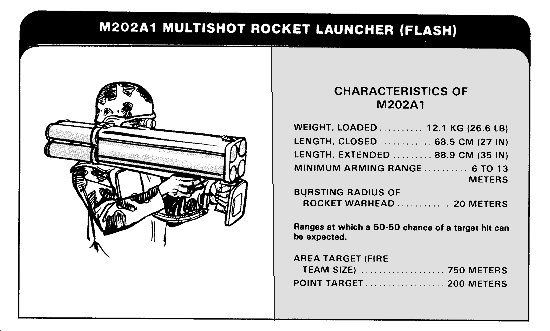
M47 DRAGON MEDIUM ANTITANK WEAPON
This is a wire-guided missile system. It is man-portable and shoulder-fired.
The Dragon actually rests on your shoulder and the front bipod legs. It has two
major components, the tracker and the round, The round (the expendable part of
the system) has two major parts, the launcher and the missile. These are
pack-aged together for handling and shipping. The launcher is both the handling
and carrying container and the tube from which the missile is fired. The tracker
is the reusable part of the system. It is designed for fast, easy detachment
from the round.
To fire the Dragon, look through the sight in the tracker, put the crosshairs
on the target, and fire. Keep the crosshairs on the target throughout the
missile's flight. The missile is continuously guided along your line-of-sight.
The tracker detects deviations from the line-of-sight and sends corrections to
the missile by a wire link.
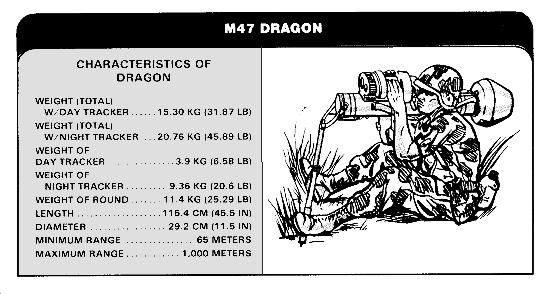
CALIBER .50 MACHINE GUN
This gun is belt-fed and recoil-operated. You can fire a single shot and
automatic from the M3 tripod mount or the M63 antiaircraft mount. Fire bursts of
9 to 15 rounds to hit ground targets from a stationary position. To fire at
aircraft, use a continuous burst, rather than several short bursts. While firing
on the move, "walk" long bursts into the target. You can suppress enemy antitank
guided missile (ATGM) gunners, vehicles, and troops with a heavy volume of fire
from the caliber .50 machine gun until a friendly maneuver element can destroy
or bypass the enemy.
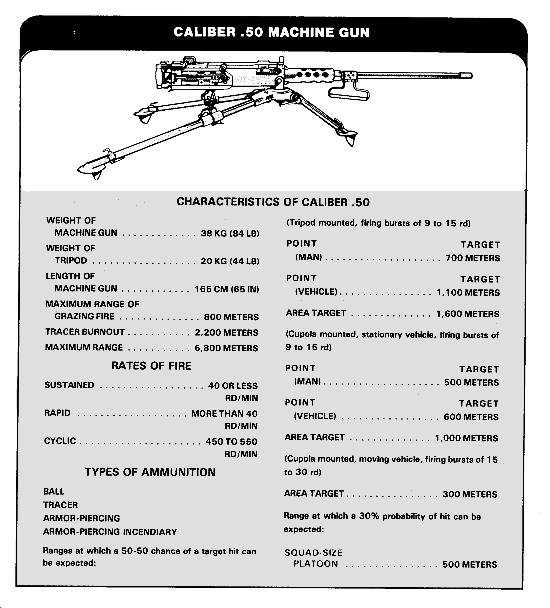
M67 90-MM RECOILLESS RIFLE (RCLR)
This RCLR is a breech-loaded, singleshot, man-portable, crew-served weapon.
You can use it in both antitank and antipersonnel roles. You can fire it from
the ground, using the bipod or the monopod, or from the shoulder. The most
stable firing position is the prone position.

CHARACTERISTICS OF FIRE
TRAJECTORY
This is the path of a projectile from a weapon to the point of impact.
At ranges out to 300 meters, the trajectory of rifle fire is almost flat. For
greater ranges, you must raise the rifle muzzle, thus raising the height of the
trajectory.
The GL has a high trajectory that is different from that of a rifle. The GL
muzzle velocity is slow when compared to that of a rifle, but it is fast enough
to have a flat trajectory out to 150 meters. For targets at greater ranges (150
to 350 meters), you must hold the GL about 20 degrees above the horizontal. This
results in a higher trajectory and increases the time of flight of the grenade
to its target. Because the trajectory is high and the time of flight long at
ranges beyond 150 meters, winds may blow the grenade off course. As a grenadier,
you must compensate for this.
DANGER SPACE
This is the space between a weapon and its target where the trajectory does
not rise above the average height of a standing man (1.8 meters). It includes
the beaten zone.
DEAD SPACE
Any area within a weapon's sector that cannot be hit by fire from that weapon
is dead space.
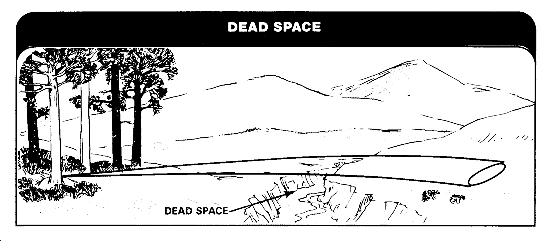
CONE OF FIRE
This is the cone-shaped pattern formed by the paths of rounds in a group or
burst. The paths of the rounds differ and form a cone because of gun vibration,
wind changes, and variations in ammunition.
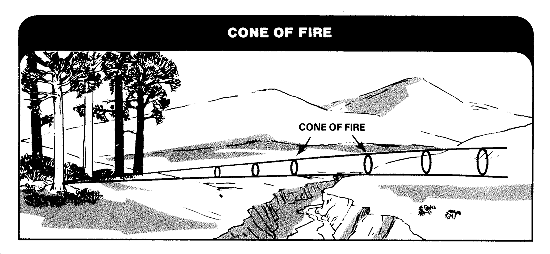
BEATEN ZONE
The area on the ground where the rounds in a cone of fire fall is the beaten
zone.
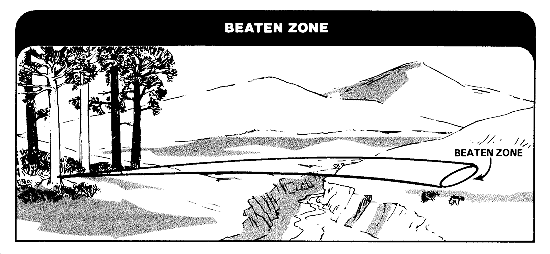
CASUALTY RADIUS
This is the area around a projectile's point of impact in which soldiers
could be killed or injured by either the concussion or fragmentation of the
projectile.
CLASSES OF FIRE
Fire is classified with respect to the ground and the target.
Fire with respect to the ground is:
-
Grazing fire when most of the rounds do not rise above 1 meter from the
ground.
-
Plunging fire when the path of the rounds is higher than a standing man
except in its beaten zone. Plunging fire is attained when firing at long
ranges, when firing from high ground to low ground, and when firing into a
hillside.
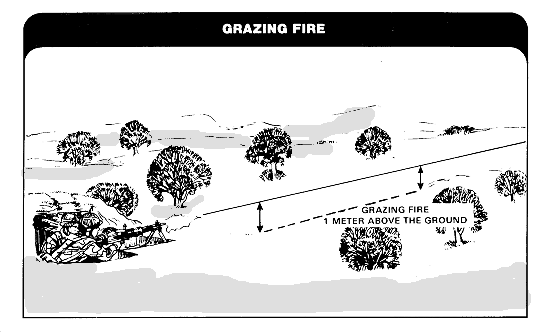

Fire with respect to the target is:
-
Frontal fire when the rounds are fired directly at the front of the
target.
-
Flanking fire when the rounds are fired at the flank of the target.
-
Oblique fire when the long axis of the beaten zone is oblique to the long
axis of the target.
-
Enfilade fire when the long axis of the beaten zone is the same as the
long axis of the target. It can be either frontal, flanking, or oblique. It is
the best type of fire with respect to the target because it makes the best use
of the beaten zone.
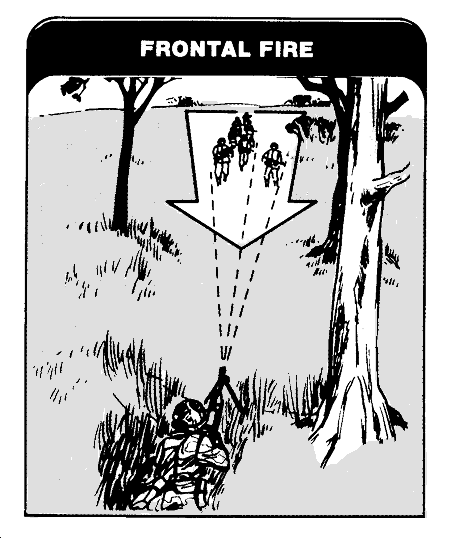

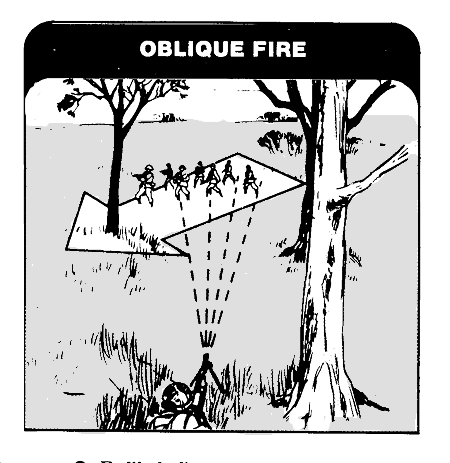

SUPPRESSIVE FIRE
Fire directed at the enemy to keep him from seeing, tracking, or firing at
the target is suppressive fire. It can be direct or indirect fire. Smoke placed
on the enemy to keep him from seeing targets is also suppressive fire.
FIRE DISTRIBUTION
When firing at an enemy position, your leader will distribute his unit's fire
to cover the position. There are two ways to distribute fire on a target--point
fire and area fire.
METHODS OF DISTRIBUTION
Point Fire. This is fire directed at one point; for example, an
entire team firing at one bunker.

Area Fire. This is fire directed to cover an area both laterally and
in depth. If your leader wants fire on a woodline, he may first fire tracers to
mark its center. Then, he may have the men on his left fire to the left of the
tracers and those on his right fire to the right of the tracers. This is the
best and quickest way to hit all parts of an area target.
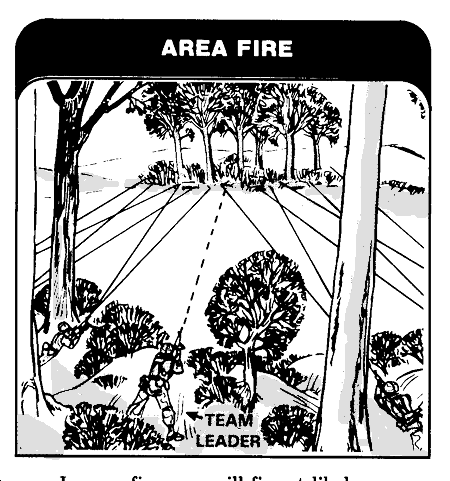
In area fire, you will fire at likely enemy positions rather than a general
area. Fire first at that part of the target relative to your position in the
team. Then distribute your fire over an area a few meters to the right and left
of your first shot.
COVERING THE TARGET AREA
AUTOMATIC RIFLEMAN
The part of the target which you, as an automatic rifleman, can hit depends
on your position and the range to the target. When possible, you cover the
entire target. When firing automatic fire, you tend to fire high; so fire low at
first and then work up to the target.
MACHINE GUNNER
As a machine gunner, fire into the part of the target assigned to you by your
leader.
DRAGON GUNNER
As a Dragon gunner, fire into the part of the target assigned to you by your
leader. Fire only at targets such as armored vehicles and key weapons. If there
are no Dragon targets, fire your rifle.
GRENADIER
As a grenadier, fire your first grenade into the center of the target. Then
distribute your shots over the remaining target area.
FIRE CONTROL
WAYS TO COMMUNICATE FIRE CONTROL
Your leader will control your fire. The noise and confusion of battle will
limit the use of some methods of control, so he will use the way or combination
of ways that does the job.
Sound. This includes both voice and devices such as whistles and
horns. Sound signals are good only for short distances. Their range and
reliability y are reduced by battle noise, weather, terrain, and vegetation.
Voice communications may come directly from your leader to you or they may be
passed from soldier to soldier.
Prearranged fire. In prearranged fire, your leader tells you to start
firing once the enemy reaches a certain point or terrain feature. When using
prearranged fire, you do not have to wait for an order to start firing.
Prearranged signals. In this method, your leader gives a prearranged
signal when he wants you to start firing. This can be either a visual signal or
a sound signal. Start firing immediately when you get the signal.
Soldier-initiated fire. This is used when there is no time to wait
for orders from your leader.
Standing operating procedures (SOP). These can reduce the number of
oral orders needed to control fire. SOPs must be known and understood by all
members of the unit. Three SOPs are the search-fire-check SOP, the return-fire
SOP, and the rate-of-fire SOP. A procedure for giving fire commands for direct
fire weapons should also be SOP.
The search-fire-check SOP, follows these steps:
Step 1
Step 2
Step 3
The return-fire SOP tells each soldier in a unit what to do in case the unit
makes unexpected contact with the enemy (in an ambush, for example). These
instructions will vary from unit to unit and from position to position within
those units.
The rate-of-fire SOP tells each soldier how fast to fire at the enemy. The
rate of fire varies among weapons, but the principle is to fire at a maximum
rate when first engaging a target and then slow the rate to a point that will
keep the target suppressed. That helps keep weapons from running out of
ammunition too fast.
FIRE COMMANDS
To help identify a target for a direct fire weapon and to control that
weapon's fire, a leader may give a fire command to that weapon.
A fire command has the following six parts:
-
Alert.
-
Direction.
-
Target Description.
-
Range.
-
Method of Fire.
-
Command to Fire.
Alert. This gets your attention. The leader may alert you by calling
your name or unit designation, by giving some type of visual or sound signal, by
personal contact, or by any other practical way.
Direction. This tells you which way to look to see the target. The
following are ways to give the direction to the target:
-
Your leader may point to a target with his arm or rifle. This will give
you the general direction of the target.
-
Your leader may fire tracer ammunition at a target to quickly and
accurately identify it. However, before firing, he should show you the general
direction.
-
Your leader may designate certain features as TRPs before contact is made
with the enemy. Each TRP will have a number to identify it. He may give a
target's direction in relationship to a TRP. For example FROM TRP 13, RIGHT
50. That means that the target is 50 meters to the right of TRP 13.
Target Description. This tells you what the target is. Your leader
should describe it briefly, but accurately. For example MACHINE GUN POSITION IN
THE WOODLINE.
Range. This tells you how far away the target is. The range is given
in meters.
Method of Fire. This tells you who is to fire. It may also tell you
how much ammunition to fire. For example, your leader may want only the
grenadier to fire at a target. He may also want him to fire only three rounds.
For example, he would say: GRENADIER, THREE ROUNDS.
Command to Fire. This tells you when to fire. It may be an oral
command, or a sound or visual signal. If your leader wants to control the exact
moment of fire, he may say AT MY COMMAND, (then pause until he is ready) FIRE.
If he wants your fire to start upon completion of the fire command, he will
simply say FIRE (without pausing).
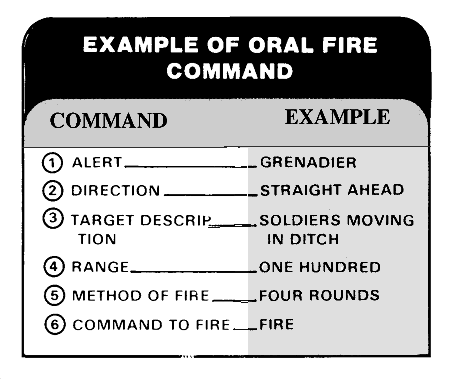
Visual signals are the most common means of giving fire commands.
Arm-and-hand signals, personal examples, and pyrotechnics are some of the things
your leader may use for visual signals.
Your leader may use arm-and-hand signals to give fire commands when you can
see him.
He may use flares and smoke grenades to mark targets in most conditions of
visibility.
Your leader may use his weapon to fire on a target as a signal; you fire when
he fires. Watch your leader and do as he does. He may use tracers to point out
targets.


